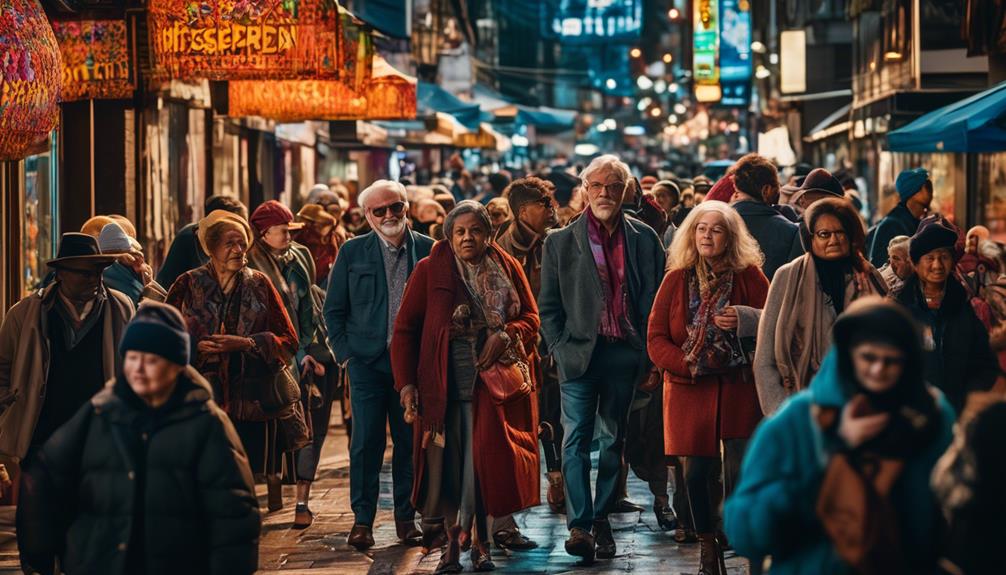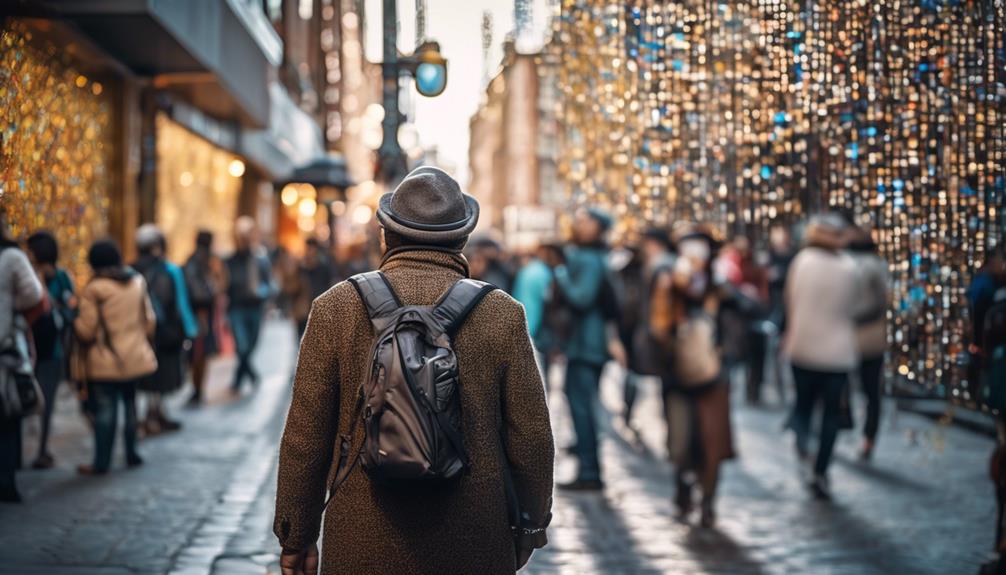Please note this post may contain affiliate links picked by me (Jay) that I have deemed may be of interest or relevant to you the reader of this.
These links do not affect the cost of the thing if you decide to purchase but i may get a little money if you choose to purchase.
For more information on my affiliate link policy click here.
I've always been fascinated by the art of candid street photography; the thrill of capturing those authentic moments that unfold in the hustle and bustle of everyday life.
But as much as I love this genre, I've come to realize the importance of approaching it with an ethical mindset. In a world where privacy is increasingly invaded, it's crucial to navigate the delicate balance between capturing compelling images and respecting the rights of those we photograph.
So, how can we ensure our street photography is both ethical and respectful? Well, let me share with you five tips that will not only help you navigate this ethical minefield but also elevate your street photography to a whole new level.
Trust me, you won't want to miss out on these valuable insights.
Key Takeaways
- Respecting privacy and obtaining consent is crucial in candid street photography.
- Being aware of cultural sensitivities and engaging with the community fosters a positive relationship.
- Ensuring ethical practices in editing and distribution preserves the authenticity and integrity of the image.
- Using candid street photography to tell compelling stories requires focusing on the narrative and enhancing storytelling through composition and visual elements.
Respect for Privacy
When it comes to candid street photography, respecting the privacy of subjects isn't just an ethical obligation, but also a crucial aspect of capturing authentic moments.
As a street photographer, it's important to understand the concept of informed consent and the legal implications associated with photographing strangers in public spaces.
Informed consent refers to obtaining permission from individuals before photographing them. While it may not always be feasible to directly ask for consent in candid street photography, it's essential to be mindful of the subjects' privacy and personal boundaries. As photographers, we've a responsibility to capture genuine moments without intruding upon someone's private life.
From a legal standpoint, photographing people in public places is generally allowed. However, it's crucial to be aware of the laws and regulations specific to your country or state. Some places may have stricter privacy laws that require obtaining consent or blurring faces if the photograph is intended for commercial use. Being knowledgeable about these legal aspects helps protect both the subjects' rights and your own as a photographer.
Respecting privacy also means being considerate of how the photograph might be used or shared. It's essential to be mindful of the context in which the image will be presented and to avoid exploiting or misrepresenting the subjects. As street photographers, we've the opportunity to capture the beauty and diversity of everyday life, but we must do so ethically and responsibly.
Obtaining Consent
One important aspect of candid street photography is obtaining consent from subjects before capturing their images. Informed consent isn't only a fundamental ethical principle in photography, but it also helps foster a positive relationship between the photographer and the subject. As a street photographer myself, I understand the importance of respecting the rights and privacy of the people I photograph.
When approaching someone for their consent, it's crucial to be respectful and explain your intentions clearly. Start by introducing yourself and briefly explaining your project or the reason behind your interest in photographing them. This not only helps establish a connection but also ensures that the subject understands the purpose of the image.
Photography ethics go hand in hand with obtaining consent. It's essential to be transparent about how the photographs will be used and shared. Will they be published in a magazine, exhibited in a gallery, or shared on social media? This information should be conveyed to the subject so they can make an informed decision about whether or not they want to be a part of your project.
Remember, not everyone will be comfortable having their picture taken, and that's perfectly okay. Respect their decision and move on. It's crucial to understand that consent isn't a one-time thing. If the subject changes their mind or expresses discomfort at any point during the process, be willing to delete the photographs or discontinue their use.
Obtaining consent is an integral part of photography ethics. By respecting the rights and privacy of the people we capture in our candid street photography, we can foster a sense of trust and ensure that our work is both innovative and respectful.
Consider Cultural Sensitivities
Now that we've covered the importance of obtaining consent in candid street photography, let's shift our focus to another crucial aspect: considering cultural sensitivities.
When it comes to capturing the diverse cultures and communities around us, it's essential to be aware of the impact our photographs can have. Cultural representation is a powerful tool, and as photographers, we've a responsibility to accurately and respectfully document the world around us.
A documentary approach to street photography allows us to preserve the authenticity and uniqueness of different cultures. By observing and capturing everyday moments, we can shed light on the beauty, struggles, and traditions that define a particular community. However, it's crucial to approach this with sensitivity and respect. We must consider the potential impact our photographs may have on the subjects and their cultural identity.
To ensure cultural sensitivity, it's essential to educate ourselves about the customs, values, and traditions of the communities we're photographing. This knowledge will help us understand what's appropriate and what may be offensive or disrespectful. By learning about their cultural practices, we can approach our subjects with empathy and treat them with the dignity they deserve.
Furthermore, it's crucial to engage with the community and build relationships based on trust. This can be done by spending time in the area, interacting with the people, and seeking permission before taking their photographs. By establishing these connections, we can create a collaborative and respectful environment, where the subjects feel comfortable and empowered.
Engage With the Community
To truly capture the essence of a community in candid street photography, it's essential to establish a genuine connection with the people who call that place home. Community involvement and building relationships are key aspects of achieving this connection. As a street photographer, I've found that engaging with the community not only enhances the quality of my photographs, but also allows me to gain a deeper understanding of the people and the culture I'm capturing.
One way to engage with the community is by attending local events and festivals. These gatherings provide a great opportunity to interact with residents, learn about their traditions, and capture candid moments filled with joy and celebration. By immersing myself in these events, I've been able to build relationships with the individuals I photograph, which adds authenticity to my work.
Another method is to frequent local establishments such as cafes, markets, or parks. These places often serve as hubs for community members to gather and socialize. By spending time in these locations, I've been able to strike up conversations with people, learn about their stories, and gain their trust. This trust is reflected in the natural and genuine expressions I'm able to capture in my photographs.
Additionally, I make an effort to give back to the community that I photograph. Whether it's through volunteering or supporting local initiatives, contributing to the well-being of the community fosters a sense of respect and reciprocity. This involvement not only strengthens the relationships I've built, but also allows me to give back to the people who've generously allowed me to document their lives.
Engaging with the community is a vital aspect of ethical candid street photography. It not only enriches the photographs we take, but also fosters a deeper connection and understanding between the photographer and the community. By immersing ourselves in the lives of the people we capture, we can truly capture the essence of a community and create powerful and meaningful photographs.
Ethical Editing and Distribution
As I continue my exploration of ethical candid street photography, an important aspect to consider is the ethical editing and distribution of the photographs I capture. Editing techniques and responsible sharing play a crucial role in ensuring that the integrity of the subjects and the story I want to convey remain intact. Here are three key points to keep in mind:
- Preserve the authenticity: When editing candid street photographs, it's essential to maintain the authenticity of the moment. Avoid excessively altering the image, as it may skew the reality or misrepresent the emotions captured. Instead, focus on enhancing the composition, contrast, and color to bring out the true essence of the scene.
- Respect the subject's privacy: As a candid street photographer, it's crucial to respect the privacy and dignity of the individuals you capture. Avoid editing or sharing photographs that could potentially invade someone's privacy or portray them in a negative light. Always ask for consent if you plan to share images featuring identifiable individuals.
- Promote responsible sharing: When distributing your candid street photographs, be mindful of the platforms and context in which you share them. Consider the potential impact your images may have on the subjects and the community. Aim to share your work in a respectful manner that educates, inspires, and sparks meaningful conversations about the human experience.
Frequently Asked Questions
How Can I Ensure That My Candid Street Photography Respects the Privacy of Individuals?
Respecting boundaries and ensuring consent are crucial when doing candid street photography. It's important to remember that people have a right to their privacy, even in public spaces. To achieve this, I always approach the situation with empathy and respect.
I try to blend in with the environment, capturing moments without intruding on someone's personal space. If I do want to photograph someone up close, I make sure to ask for their permission first.
Are There Any Legal Considerations I Should Be Aware of When Obtaining Consent for Candid Street Photography?
Legal considerations are crucial when it comes to obtaining consent for candid street photography. It's important to be aware of the laws surrounding privacy and image rights to ensure you're on the right side of the law.
By obtaining proper consent, you not only protect yourself from legal repercussions but also show respect for the individuals you photograph.
What Are Some Cultural Sensitivities to Keep in Mind While Engaging in Candid Street Photography?
When engaging in candid street photography, it's crucial to be aware of cultural sensitivities. Respecting ethical boundaries is essential.
Different cultures have varying expectations of privacy and may have certain subjects that are considered off-limits.
It's important to approach people with sensitivity and respect their wishes if they don't want to be photographed.
How Can I Actively Engage With the Community While Practicing Candid Street Photography?
When it comes to candid street photography, community engagement is key! Building relationships with the people you photograph can make a world of difference in the ethicality of your work.
Actively engaging with the community allows you to understand their perspectives, gain trust, and capture more authentic moments. Whether it's striking up conversations, attending local events, or supporting local businesses, immersing yourself in the community won't only enhance your photography but also create a positive impact.
What Are Some Ethical Guidelines to Follow When Editing and Distributing Candid Street Photography?
When it comes to ethical editing and responsible distribution of candid street photography, there are a few guidelines that I always keep in mind.
Firstly, I make sure to respect the privacy and dignity of the individuals captured in my photos. I avoid manipulating or altering the images in a way that misrepresents reality.
Secondly, I obtain necessary permissions when sharing or selling the photographs.
Lastly, I strive to create a dialogue and raise awareness about the social issues portrayed in my work.
Conclusion
In conclusion, ethical candid street photography encompasses several important aspects. These include capturing great shots, respecting people's privacy, obtaining consent, being culturally sensitive, engaging with the community, and practicing ethical editing and distribution.
Some may argue that adhering to these guidelines can be challenging and limit creativity. However, it is crucial to remember that ethical photography not only preserves the dignity of the subjects but also fosters a deeper connection with the community. This deeper connection ultimately leads to more meaningful and impactful photographs.
So, let's grab our cameras and venture out into the world around us. As we do so, let's make a conscious effort to respect and celebrate the lives we encounter, ensuring that our candid street photography is both ethical and meaningful.


